
Taken at Bank Underground station. PICTURE: Étienne Godiard/Unsplash

Taken at Bank Underground station. PICTURE: Étienne Godiard/Unsplash
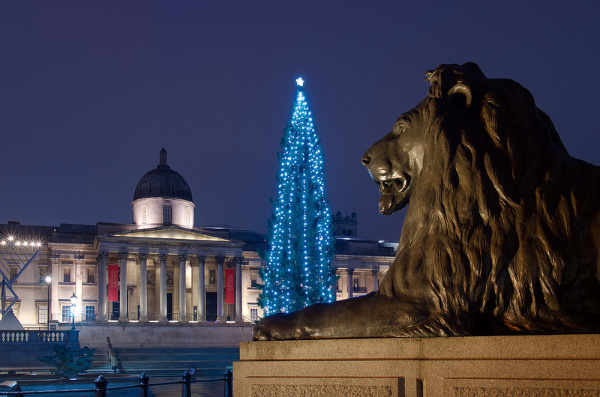
• The traditional Trafalgar Square tree lighting ceremony has gone virtual for the first time this year due to coronavirus restrictions. The online event, which will be held at 6pm on 3rd December via YouTube and Facebook, will include messages from the Lord Mayor of Westminster and the Mayor of Oslo as well as information on the history behind the gift of the tree, footage of its journey from the forests of Norway to London, and performances from the Salvation Army, the Poetry Society and the St Martin-in-the-Fields Choir. While the tree felling ceremony in Norway is usually attended by the Lord Mayor of Westminster, this year COVID restrictions meant he was represented by the British Ambassador to Norway, Richard Wood, who was joined by the Mayor of Oslo, Marianne Borgen, and school children from Maridalen school in Oslo, to witness the tree begin its journey to London. A Norwegian spruce has been given by the people of Oslo to the people of the UK in thanks for their support during World War II in the lead-up to every Christmas since 1947. Once the tree arrives in London, it is decorated with Christmas lights in a traditional Norwegian manner. For more on the tree, see westminster.gov.uk/trafalgar-square-christmas-tree.
• Eighteenth century anti-slavery campaigner Ottobah Cugoano – a former slave himself – has been honoured with an English Heritage Blue Plaque. The plaque is located at Schomberg House at 80–82 Pall Mall, the property where he was employed as a servant by artists Richard and Maria Cosway. It was while living here in the 1780’s that Cugoano wrote the book, Thoughts and Sentiments on the Evil and Wicked Traffic of the Slavery and Commerce of the Human Species, Humbly Submitted to the Inhabitants of Great-Britain, one of the first black-authored anti-slavery books to be published in Britain. The house was actually mentioned in the frontispiece of the 1787 edition of Thoughts and Sentiments as one of the places where copies of the book might be obtained. It is, says English Heritage, “evidence of the Cosways’ support for their servant’s endeavours as an author and a campaigner”. For more, see www.english-heritage.org.uk/visit/blue-plaques/.
• Somerset House is offering virtual tours of its exhibition Leila Alaoui: Rite of Passage. The exhibition is the first major retrospective of the work of Alaoui, a celebrated French-Moroccan photographer, video artist and activist who died in a terrorist attack at the age of 33 while working on a photography project promoting women’s rights in Burkina Faso in 2016. Guided by award-winning broadcaster and cultural commentator Ekow Eshun, the tour of the exhibition takes in three of the artist’s defining series – No Pasara, which documents the lives of North African migrants trying to reach Europe; Natreen (We Wait), which follows families trying to flee the Syrian conflict, and Les Marocains, which, inspired by Robert Frank’s The Americans, meets the many individuals who make up the multifaceted fabric of contemporary Morocco. The exhibition also includes an unfinished video project L’Ile du Diable (Devil’s Island) which Alaoui was working at the time of her death, featuring dispossessed migrant workers at the old Renault factory in Paris. The free tour can be accessed at www.somersethouse.org.uk/blog/virtual-tour-leila-alaoui-rite-passage.
Send all items for inclusion to exploringlondon@gmail.com.
This ornate Baroque archway only stands with walking distance from where it originally stood marking the entrance to the City of London. But it came to this position by a somewhat roundabout route.
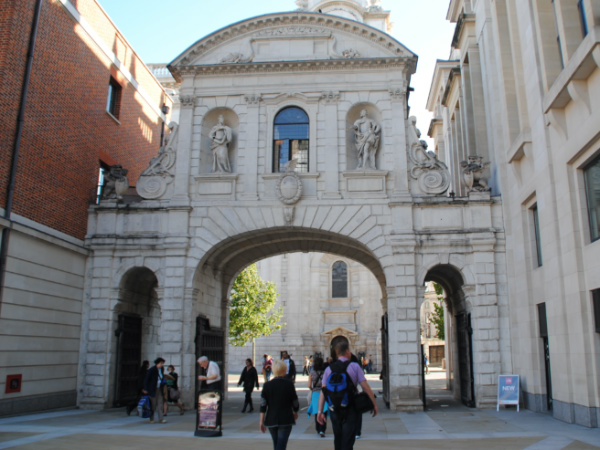
The gate was originally constructed at the junction where Fleet Street becomes the Strand, it marked the boundary between the City of London and Westminster.
While the first gate on the site dates back to the 14th century (prior to that the boundary was apparently marked with a chain two posts), the gate we see today dates from 1672 when, despite having survived the Great Fire of London, the previous gate – a crumbing wooden structure – was demolished and this upmarket replacement built to the design of none other than Sir Christopher Wren (earlier designs for the gate created by Inigo Jones were never acted upon).
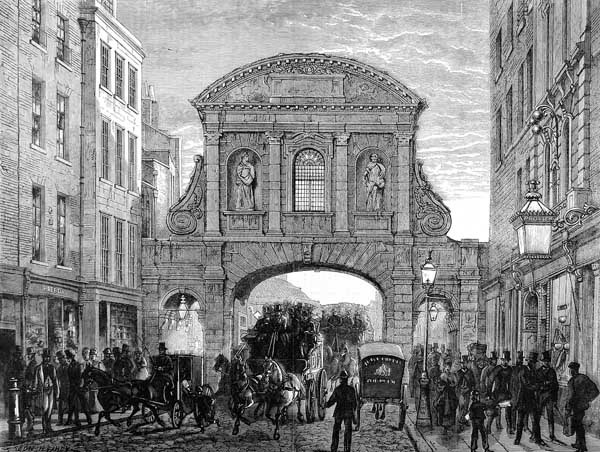
Made of Portland stone, the new structure featured figures of King Charles I and King Charles II on the west side and King James I and Queen Anne of Denmark on the east (it’s said that a third of the total £1,500 cost was spent on the statuary alone).
Shortly after its construction, it became a location for the display of the remains of traitors (usually heads), the first of which were the body parts of Rye House plotter Sir Thomas Armstrong and the last of which was the head of Jacobite Francis Towneley in 1746 (there’s also a story that such was the interest when the heads of the Rye House plotters – who had planned to assassinate King Charles II and crown his brother, the future King James II, in his place – were displayed, telescopes were rented out so people could get a closer look).
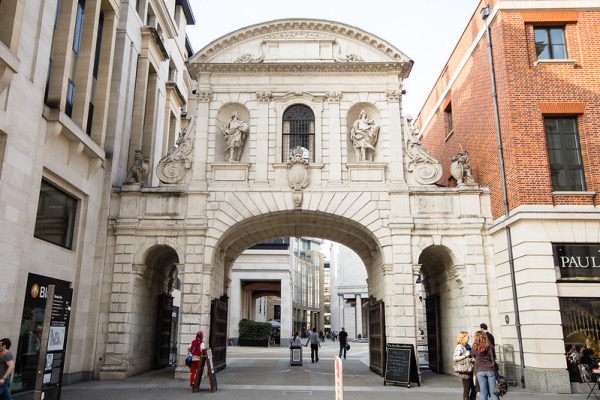
Among the luminaries who passed under the central arch were Anne Boleyn (the day before her coronation) and Queen Elizabeth I. The Queen did so most famously on her way to give thanks in St Paul’s Cathedral for the English victory over the Spanish Armada and since then, whenever a Sovereign has wanted to enter the City past Temple Bar, there’s been a short ceremony in which the Sovereign asks permission of the Lord Mayor of London to enter. Granting this, the Mayor then offers the Sword of State as a demonstration of loyalty and this is subsequently carried before the Sovereign as they proceed through the City as a sign of the Lord Mayor’s protection.
The Temple Bar stood in its original location until 1878 when, to help traffic flow, it was carefully removed brick-by-brick over a period of 11 days (the City of London Corporation well aware of its historical significance) . It was initially intended that the gateway would be rebuilt somewhere else in the city, but time passed and no suitable site was found.
Instead, the gate lay in pieces in a yard in Farringdon Road before, in the mid 1880s, Sir Henry Bruce Meux had all 2,500 stones transported via trolleys pulled by horses to his estate at Theobalds Park in Hertfordshire and re-erected there as a gateway (the Lady Meux apparently used the small upper room for entertaining – among those said to have dined here was King Edward VII and Winston Churchill).
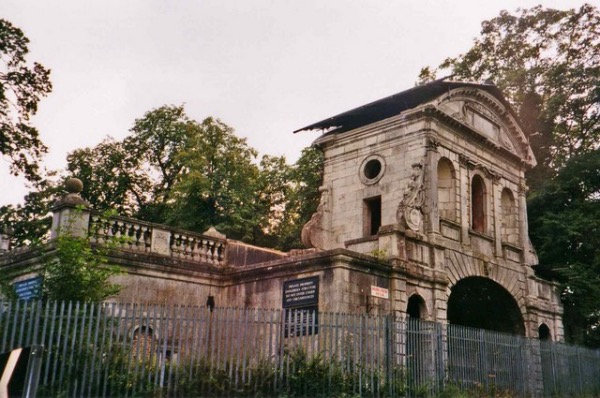
In 1976, the Temple Bar Trust was formed to have the archway returned to London – they eventually succeeded 30 years later in 2004 when it was re-erected on its current site between St Paul’s and Paternoster Square at a cost of some £3 million.
The original site of the Temple Bar is now marked with a Victorian era memorial – erected in 1888 – which features statues of Queen Victoria and Edward, the Prince of Wales.
A Black Lives Matter tribute shirt worn by Arsenal captain Pierre-Emerick Aubameyang during the 2020-21 Premier League season is being donated to the Museum of London as part of its Collecting COVID project. The Black Lives Matter logo was added to all Premier League shirts following anti-racism protests across the globe earlier this year. Aubameyang – the latest Black player to captain Arsenal – said it was “an honour to have the opportunity to donate my Black Lives Matter shirt to the Museum of London’s Collecting COVID project”. “I hope this will be remembered as the moment that football stood against all forms of racism and that it will inspire young people for the future,” he said. The Collecting COVID project was launched in April this year with the aim of collecting objects relating to how Londoners lived during coronavirus pandemic. For more, see www.museumoflondon.org.uk/discover/museum-for-london-collecting-covid.
A memorial commemorating the role of the Chindit Special Forces in Burma during World War II has been awarded a Grade II listing on the National Heritage List for England in honour of the 75th anniversary of Victory in Japan (VJ) Day. Located in Victoria Embankment Gardens outside the Ministry of Defence building in Whitehall, the memorial’s granite plinth is topped with a bronze chinthe, a mythical beast that stands guard outside Burmese temples. The Chindit Special Forces, which were formed by British Army officer Major General Orde Charles Wingate and disbanded in early 1945, are credited with helping to turn the tide of World War II against Japan in the Far East. The memorial was designed by architect David Price and the chinthe sculpture the work of Frank Forster. It was unveiled by Prince Philip on 16th October, 1990. On Saturday, as the nation commemorated VJ Day, a military delegation lad a wreath at the foot of the memorial. PICTURE: Derek Voller (licensed under CC BY-SA 2.0).
St Paul’s Cathedral has opened an online book of remembrance for people living in the UK who have died as a result of COVID-19. The Remember Me website is open to family, friends and carers of those who have died to submit, free-of-charge, the name, photograph and a short message in honour of the deceased. The book, which will remain open for as long as is required, will eventually be accompanied by a physical memorial which is planned for the cathedral’s north transept. The Very Revd David Ison, Dean of St Paul’s, said that for centuries, St Paul’s has been a place to remember the “personal and national impact of great tragedies”. “Remember Me is an opportunity to mourn every person we have lost to the effects of this terrible disease, an encouragement to offer compassion and support to those left behind, and an ongoing recognition of the impact of the pandemic on the UK.” The launch of the website last week – which has the support of Prince Charles – was accompanied by the release of a specially recorded piece of music featuring the choristers of St Paul’s, the Remember Me Anthem – Lift Thine Eyes (see below). PICTURE: Screenshot of the memorial website.
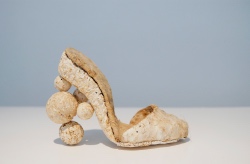 • Somerset House is releasing a new virtual tour of its exhibition Mushrooms: The Art, Design and Future of Fungi so people can explore the world of the mushroom and its role in the world’s survival from home. The exhibition, which will go live online on Monday to mark International Museum Day, features highlights including Beatrix Potter’s watercolours of mushrooms, conceptual artist Carsten Höller’s spinning, solar-powered mushrooms, a psychedelic film by Adham Faramawy, Seana Gavin’s hand-cut collages of mushroom-human hybrids and, shoes and shades made from mycelium, the fungal mass which lies beneath the earth under mushrooms. The exhibition will be released online on 18th May at www.somersethouse.org.uk. PICTURED: Kristen Peters, Mycoshoen, courtesy of the artist.
• Somerset House is releasing a new virtual tour of its exhibition Mushrooms: The Art, Design and Future of Fungi so people can explore the world of the mushroom and its role in the world’s survival from home. The exhibition, which will go live online on Monday to mark International Museum Day, features highlights including Beatrix Potter’s watercolours of mushrooms, conceptual artist Carsten Höller’s spinning, solar-powered mushrooms, a psychedelic film by Adham Faramawy, Seana Gavin’s hand-cut collages of mushroom-human hybrids and, shoes and shades made from mycelium, the fungal mass which lies beneath the earth under mushrooms. The exhibition will be released online on 18th May at www.somersethouse.org.uk. PICTURED: Kristen Peters, Mycoshoen, courtesy of the artist.
• The V&A are seeking homemade signs created during the coronavirus lockdown – everything from children’s rainbow signs to handwritten notes placed in public spaces – to add to its permanent collection. Noting the commonplace nature of such signs during the emergency, the V&A have said that “[w]hether they state temporary closure of a business, express messages of hope or critique, or raise awareness for a good cause, these signs have become a prominent way for us to communicate with the outside world during lockdown”. Through collecting the signs, the museum is aiming to “create and preserve a rich portrait of life under lockdown expressed through visual imagery.” Selected signs will be chosen to join the museum’s collections. Signs can be submitted to homemadesigns@vam.ac.uk while people are also encouraged to share signs they’ve come across on social media using #homemadesigns.
• The National Trust is asking people to write letters to its Director General Hilary McGrady, about their lockdown experiences in order to add a selection of them to its collection of historic letters. People are asked to write about what they have most missed since lockdown began and about what solace they may have drawn from nature, art, creativity and any forms of social contact. The National Trust is asking writers to scan or photograph their letter and email it to lettersfromlockdown@nationaltrust.org.uk or share it via the National Trust’s social media channels using @nationaltrust to ease pressure on the postal service. The Trust says it will request postal hard copies from selected authors at a later date.
Send all items for inclusion to exploringlondon@gmail.com
Seen in Brockley, south London. PICTURE: Loco Steve (licensed under CC BY-SA 2.0)
• It’s 169 years since the Crystal Palace served as the centrepiece of the ‘Great Exhibition of the Works of Industry of All Nations’ in Hyde Park but for the first time you now have a chance to tour the building virtually. The Royal Parks, working in partnership with educational virtual reality company, Seymour & Lerhn, have recreated the grand glass and iron structure which hosted thousands of exhibits from across the globe at the 1851 exhibition which was spear-headed by Prince Albert. The building has been regenerated digitally using The Royal Commission for the Exhibition’s archive of plans and images, as well as The Royal Parks’ historical documents including old maps. The tour overlays this historic footage over the site as it is now and visitors can switch between the two as well as learn about some of the fascinating stories connected to the Great Exhibition including that of the construction of the first ever public toilets and that of the lady who walked from Cornwall to attend the display. The virtual tour is free to access at www.royalparks.org.uk/parks/hyde-park/things-to-see-and-do/the-great-exhibition-virtual-tour.
• The National Museum of the Royal Navy, National Army Museum and Royal Air Force Museum are hosting their first tri-service celebration with a ‘Virtual VE Day 75 Festival’ to mark the 75th anniversary of the end of the war in Europe. The festival runs from today until 9th May and kicks off with ‘Vying for Victory: Britain’s Navy, Army and Air Force in Myth and Memory’ featuring representatives from the museums discussing the service’s respective roles during the closing stages of World War II. Other events include a live webinar featuring historian and broadcaster James Holland speaking to the National Army Museum’s Dr Peter Johnston about ‘Why the Allies Won’, re-enactors sharing stories from real service personnel during the World War II, and an immersive walk-through of HMS Alliance which will provide insights into the isolation experience of submariners on VE Day. For the full programme of events, head to Virtual VE Day 75 Festival.
• The National Portrait Gallery is launching a new community photography project to capture a snapshot of the nation during the coronavirus lockdown. People are being encouraged to submit pictures responding to three themes – ‘Helpers and Heroes’, ‘Your New Normal’ and ‘Acts of Kindness’ – to the project which is called Hold Still. Launched by the Duchess of Cambridge, patron of the gallery, this week, the project is open to Britons of all ages and will see 100 short-listed pictures featured in a digital exhibition. The closing date for submissions is 18th June. Head to www.npg.org.uk/hold-still/ for more.
Send all items for inclusion to exploringlondon@gmail.com.
• The Museum of the Home has launched a new national collecting project aimed at documenting people’s lives during the coronavirus lockdown. Called Stay Home, the project involves answering seven questions about you and your home and sharing up to five images of your home as well as some personal demographic information. Contributions will become part of the museum’s Documenting Homes collection, an archive of almost 8,000 items which represents homes from the 1900s up to the present day. To take part – or to read the stories of those who have, head to www.museumofthehome.org.uk/explore/stay-home-collecting-project/. The museum is planning to reopen in September following a major redevelopment which includes the renovation of the Grade I-listed Geffrye Almshouses and the development of new spaces which will create 80 per cent more space for exhibitions, events and collections. The reopening will, of course, depend on the situation with regard to the COVID-19 outbreak.
• Visits to the National Trust’s home baking pages have increased by almost 900 per cent since the country was locked down in mid-March. Cheese scones have proved the most popular nationally with more than 54,000 people visiting the page in the first four weeks of lockdown – an increase of 3,009 per cent on last year. Second place is apple and rhubarb crumble with almost 15,000 visits (an increase of 581 per cent) and the fruit scone is in third place at almost 10,000 visits (an increase of 737 per cent). Meanwhile in London, favourites include potato and onion soup in Barnet, Westminster and Redbridge, apple cinnamon bun in Islington, chocolate nests in Enfield, and vegetable and coconut curry in Sutton. To visit the recipe pages, head to www.nationaltrust.org.uk/recipes.
• Captain Tom Moore – the World War II veteran who has raised more than £29 million for the NHS – will be the first person to be virtually invested with the Freedom of the City of London. Moore, who celebrates his 100th birthday today, made headlines internationally when he completed 100 laps of his garden in the hope of raising £1,000 to support NHS Charities Together. The investiture ceremony will be conducted next week and is believed to be the first time it’s been conducted virtually since the Freedom was first awarded in 1237.
Send all items for inclusion to exploringlondon@gmail.com.
Boris Johnson returns to 10 Downing Street, home of the Prime Minister, on Monday, having recovered from COVID-19. PICTURE: Andrew Parsons/No 10 Downing Street (licensed under CC BY-NC-ND 2.0)
Have an item that shows how your life has changed since the arrival of the novel coronavirus in London in January?
 The Museum of London is seeking to build a collection of objects and first-hand experiences related to the coronavirus pandemic in a bid to ensure future generations of Londoners will be able to learn about and understand this extraordinary period in the city’s history.
The Museum of London is seeking to build a collection of objects and first-hand experiences related to the coronavirus pandemic in a bid to ensure future generations of Londoners will be able to learn about and understand this extraordinary period in the city’s history.
The museum, which already holds collections related to disease outbreaks such as the 1889 -1893 and 1918 flu pandemics, is looking for both physical and digital objects related to three main themes – how the physical spaces in the city have been transformed, the effects on key and home workers, and how children and young people are reacting to and coping with the changes now that many schools are closed.
Like those in existing pandemic-related collections – such as the dress Queen Victoria wore to mourn the loss of her grandson to influenza in 1892 (pictured – right) or an 1832 cholera notice issued for St Katharine Docks (pictured – top), the COVID-19-related objects will serve as a reminder of the suffering people are experiencing but also tell the story of the pandemic’s effect on society and culture.
“Londoners, like millions of people around the world, have to find ways of coping with the new life the epidemic has imposed,” says Beatrice Behlen, senior curator at the Museum of London.
“This is a major moment in the capital’s history and we want to collect a range of objects, from clothing to hairclippers, from diaries to memes that reflect the physical and emotional response of Londoners to COVID-19. The Museum of London always strives to tell the story of London and its people. We feel it is imperative to capture this time for future generations, to help us understand how this city dealt with an extraordinary situation.“
Individuals and organisations who would like to donate objects should get in touch via social media @MuseumofLondon or email enquiry@museumoflondon.org.uk.
PICTURES: Top – Printed cholera notice issued by the Secretary of St Katharine Dock Company; Right – Dress ensemble, 1892. Worn by Queen Victoria when in mourning for her grandson, the Duke of Clarence, who died in the flu pandemic in 1893. (© Museum of London)
Send all items for inclusion to exploringlondon@gmail.com
 This Greenwich statue, which stands on King William Walk to the left of the entrance to the Pepys Building – once part of the Royal Naval College, depicts the Elizabethan adventurer and court favourite (well, at times) in a suitably heroic pose. The life-sized bronze of Raleigh (1552-1618), which stands on a stone plinth, was designed by William McMillan. It was originally unveiled by then-US Ambassador John Hay Whitney in 1959 on Raleigh Green outside the Ministry of Defence in Whitehall to mark the 350th anniversary of the foundation of the Commonwealth of Virginia (it was apparently originally suggested it be placed in front of the National Gallery in Trafalgar Square but that didn’t eventuate). Grade II-listed, it stood in Whitehall until 2001 until, deemed as out of scale with other statues, was moved to its current location. PICTURE: Loco Steve (licensed under CC BY-SA 2.0).
This Greenwich statue, which stands on King William Walk to the left of the entrance to the Pepys Building – once part of the Royal Naval College, depicts the Elizabethan adventurer and court favourite (well, at times) in a suitably heroic pose. The life-sized bronze of Raleigh (1552-1618), which stands on a stone plinth, was designed by William McMillan. It was originally unveiled by then-US Ambassador John Hay Whitney in 1959 on Raleigh Green outside the Ministry of Defence in Whitehall to mark the 350th anniversary of the foundation of the Commonwealth of Virginia (it was apparently originally suggested it be placed in front of the National Gallery in Trafalgar Square but that didn’t eventuate). Grade II-listed, it stood in Whitehall until 2001 until, deemed as out of scale with other statues, was moved to its current location. PICTURE: Loco Steve (licensed under CC BY-SA 2.0).
The oldest existing French patisserie in London is said to be Maison Bertaux, based in Greek Street in Soho.
The premises, where you can still indulge in delights including eclairs, croissants and delectable fruit tarts, was founded in 1871 by one Monsieur Bertaux, apparently a French communard from Paris.
It lies at the heart of what was then the city’s French community and located at number 28, stands next door to another Soho landmark, the Coach and Horses pub.
Bertaux apparently ran the business until 1909 and it’s since passed through a number of hands with current owners, sisters Michele and Tania Wade, reported as having taken over in 1988.
Famous patrons have reportedly included writers Virginia Woolf and Karl Marx, actors Steve McQueen and Nicole Kidman, artist Grayson Perry and musician Bob Geldof. The patisserie also famously made Lily Allen’s wedding cake and hosted the late fashion designer Alexander McQueen’s 25th birthday party.
Bastille Day celebrations are, of course, a highlight of the year.
For more, see www.maisonbertaux.com.
PICTURE: Google Maps.
Andrew Baker, author of the recently published From Bean To Bar: A Chocolate Lover’s Guide to Britain, talks about some of his favourite chocolate spots in London…
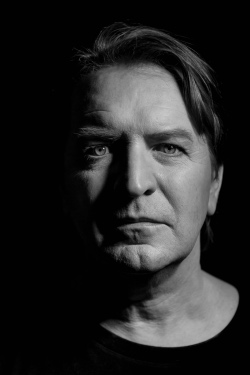 London is full of secret and out-out-the-way chocolate spots – some of them destined to remain out of the public eye.
London is full of secret and out-out-the-way chocolate spots – some of them destined to remain out of the public eye.
The Queen’s favourite chocolates, for example, are made by the Prestat company in a marvellous factory crammed with delicious and exotic ingredients – and almost in the shadow of the prison at Wormwood Scrubs. As well as Her Majesty, Prestat’s lovely truffles were a favourite of the author Roald Dahl, of Charlie and the Chocolate Factory…but this particular chocolate factory remains off-limits to visitors.
The same goes for the premises in Bethnal Green at which Phil Landers is currently the only person in the entire metropolis making chocolate from scratch, or “from bean to bar” as the technique is properly known. Phil’s lovely bars are available from his website and might be said to be the authentic taste of London chocolate.
But one place where you can both enjoy the finished product and – from time to time – watch it being made and chat with the master behind it is Paul A Young’s eponymous shop at 143 Wardour Street (pictured).
This long-established thoroughfare has existed along its present course since at least the 16th century, and in its time has been justly celebrated as a location for the stars of the music industry (David Bowie and The Jam, among many others) and the movie industry, which still retains a hefty presence.
PICTURE: Google Maps
But Young’s lovely purple corner shop has become a celebrated place of pilgrimage for fans of all things chocolatey.
The ginger-bearded, twinkly and genial Young has become one of Britain’s best-known chocolatiers through frequent appearances in print, online and on television, most notably making the treats of yesteryear in the deliciously nostalgic series The Sweet Makers.
But there is substance behind the fluency and charm: years of training as a pastry chef, working at an early stage with the superstar chef Marco Pierre White, and years of experience in the kitchens of his shops.
There are branches in Camden and Threadneedle Street in the City, but the most substantial outpost of his empire is here in Soho. This is a must-visit location not only for fans of filled chocolates – for Young is one of the finest exponents of those of those in the world – but also for barflys, because he stocks a full range of bars made by the wonderful Cleethorpes bean-to-bar maestro Duffy Sheardown. What is more, Young serves an enormously tempting cup of hot chocolate ladled, in the winter months, from a glorious copper cauldron steaming in the shop window. What better way to lure in customers on a chilly day?
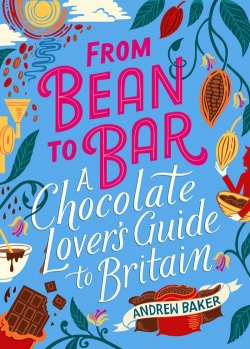 The Barnsley-born Young is often to be found exploring new flavour combinations in the kitchen in the shop’s basement. There are frequent chocolate-making classes here as well, and there is no-one better at imparting, in a kindly and witty manner, the mysteries of tempering and ganache-making.
The Barnsley-born Young is often to be found exploring new flavour combinations in the kitchen in the shop’s basement. There are frequent chocolate-making classes here as well, and there is no-one better at imparting, in a kindly and witty manner, the mysteries of tempering and ganache-making.
But he is at his best inventing wonderful new combinations of fine chocolate and delicious fillings, and it would be a foolish visitor to London who departed the capital without sampling at least several of Young’s most celebrated truffles – the Marmite version, for example, which I adore, the beer and crisp version made with Camden’s Brewdog ale, or the homage to his roots in the Yorkshire tea and biscuit truffle.
These and many, many more are laid out in mouthwatering rows in the Wardour Street shop, freshly made and so to be consumed as soon as possible. That is not a difficult piece of advice to heed.
From Bean To Bar: A Chocolate Lover’s Guide to Britain: is published by AA Publishing.
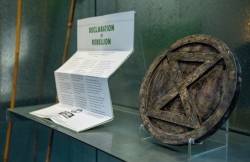 • Objects relating to climate change protest group Extinction Rebellion have gone on display at the V&A. The items, which can be seen in the V&A’s Rapid Response Collecting Gallery, range from the open source ‘Extinction Symbol’ created by street artist ESP in 2011 and adopted by the group, known as XR, in 2018 through to the first ‘Declaration of Rebellion’ pamphlet and flags carried during demonstrations. The objects – which also include a child’s high-vis jacket worn during a peaceful XR protest which has gone on display at the V&A Museum of Childhood in Bethnal Green – were given by the Extinction Rebellion Arts Group, a coalition of graphic designers, artists and activists responsible for XR’s design programme. The exhibition is free. For more, see www.vam.ac.uk. PICTURE: © V&A London
• Objects relating to climate change protest group Extinction Rebellion have gone on display at the V&A. The items, which can be seen in the V&A’s Rapid Response Collecting Gallery, range from the open source ‘Extinction Symbol’ created by street artist ESP in 2011 and adopted by the group, known as XR, in 2018 through to the first ‘Declaration of Rebellion’ pamphlet and flags carried during demonstrations. The objects – which also include a child’s high-vis jacket worn during a peaceful XR protest which has gone on display at the V&A Museum of Childhood in Bethnal Green – were given by the Extinction Rebellion Arts Group, a coalition of graphic designers, artists and activists responsible for XR’s design programme. The exhibition is free. For more, see www.vam.ac.uk. PICTURE: © V&A London
• The City of London has launched an alternative giving campaign aimed at helping the City’s homeless and rough sleepers, establishing four contactless card points where people can donate £3 a time. The contactless devices, which donate the money to homelessness charity Beam, are located at the City of London Information Centre in St Paul’s Churchyard, the Barbican Library, the Tower Bridge’s engine room and the Guildhall West Wing reception window. The campaign will run for three months.
Send all items for inclusion to exploringlondon@gmail.com.
News today that Boris Johnson will be the next Prime Minister of the UK. Johnson, who will take over from Theresa May – only the second woman to hold the office – as PM tomorrow after winning the Conservative Party vote over Foreign Secretary Jeremy Hunt, will be the 14th Prime Minister to serve in the office during the reign of Queen Elizabeth II. PICTURE: US State Department
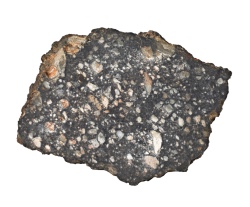 • Lunar samples collected during the Apollo 11 mission and objects that travelled to the Moon with the astronauts including Edwin “Buzz” Aldrin’s “Snoopy Cap” and the famous Hasselblad camera equipment are among items on display as part of a new major exhibition which opens at the National Maritime Museum in Greenwich on Friday. Celebrating the 50th anniversary of the 1969 Moon landing, The Moon explores Earth’s relationship with the Moon over time and across civilisations. Other items among the more than 180 objects from public and private collections on show include a rare lunar meteorite from the Natural History Museum’s collection (pictured), a Mesopotamian tablet from 172 BC and a series of contemporary and historical artworks including paintings by JMW Turner and John Constable. There’s also a new version of Christian Stangl’s film Lunar in which animated photographs from Apollo missions allow visitors to experience the Moon landings through the eyes of the astronauts. The Moon can be visited until 5th January. Admission charges apply. For more, see www.rmg.co.uk/moon50. PICTURE: Lunar meteorite Found in the Sahara Desert, North West Africa, 2017 © The Trustees of the Natural History Museum, London.
• Lunar samples collected during the Apollo 11 mission and objects that travelled to the Moon with the astronauts including Edwin “Buzz” Aldrin’s “Snoopy Cap” and the famous Hasselblad camera equipment are among items on display as part of a new major exhibition which opens at the National Maritime Museum in Greenwich on Friday. Celebrating the 50th anniversary of the 1969 Moon landing, The Moon explores Earth’s relationship with the Moon over time and across civilisations. Other items among the more than 180 objects from public and private collections on show include a rare lunar meteorite from the Natural History Museum’s collection (pictured), a Mesopotamian tablet from 172 BC and a series of contemporary and historical artworks including paintings by JMW Turner and John Constable. There’s also a new version of Christian Stangl’s film Lunar in which animated photographs from Apollo missions allow visitors to experience the Moon landings through the eyes of the astronauts. The Moon can be visited until 5th January. Admission charges apply. For more, see www.rmg.co.uk/moon50. PICTURE: Lunar meteorite Found in the Sahara Desert, North West Africa, 2017 © The Trustees of the Natural History Museum, London.
• London’s inaugural and free week long National Park City Festival kicks off on Saturday to celebrate the city’s green spaces, wildlife and waterways. Opening the festival – which is an initiative of the Mayor of London and National Park City Foundation as well as other partners – this weekend is a free cultural programme, run in partnership with the National Theatre, on its outdoor river stage on South Bank which features dance, theatre and music. Other highlights among the more than 300 events being held during the nine day event include the ‘National Park City Rooftops’ initiative – which sees people given free access to some of the city’s most beautiful garden rooftops and natural spaces including Crossrail Place in Canary Wharf, Barbican Conservatory and Ham Yard Hotel in Soho, the ‘National Park City Forest’ initiative which sees a unique audio installation, Living Symphonies, installed in Epping Forest, the ‘National Park City Wildlife’ – a photography competition and exhibition held in partnership with the London Wildlife Trust, and the multi-site ‘National Park City Splash’ initiative in which everybody can try their hand at activities like paddle boarding and open water swimming. The week runs to 28th July. For the complete programme of events, head to https://nationalparkcity.london.gov.uk.
• The work of Finnish artist Helene Schjerfbeck (1862 – 1946) is being celebrated at the Royal Academy of Arts. Opening on Saturday, the first solo UK exhibition of Schjerfbeck’s works features some 65 portraits, landscapes and still lifes, and follows the development of the artist’s work from a naturalistic style, inspired by French Salon painters in the early 1880s, to what the RA describes as “a radically abstracted and modern approach from the turn of the 20th century onwards”. The exhibition is being shown in five sections with highlights including Two Profiles (1881) – the earliest work on display, The Convalescent (1888), My Mother (two paintings – one from 1902 and another from 1909), a series of self-portraits and later works like Måns Schjerfbeck (The Motorist) (1933) and Three Pears on a Plate (1945). Runs until 27th October in The Gabrielle Jungels-Winkler Galleries. Admission charge applies. For more, see www.royalacademy.org.uk.
Send all items for inclusion to exploring london@gmail.com.
Close-up of the facade of Mizuho House, London branch of the Japanese investment bank Mizuho, in the Old Bailey London. PICTURE: Valdemars Magone/Unsplash
Millennium Bridge crossing the Thames between the City of London and South Bank. PICTURE: Toa Heftiba/Unsplash (image cropped).